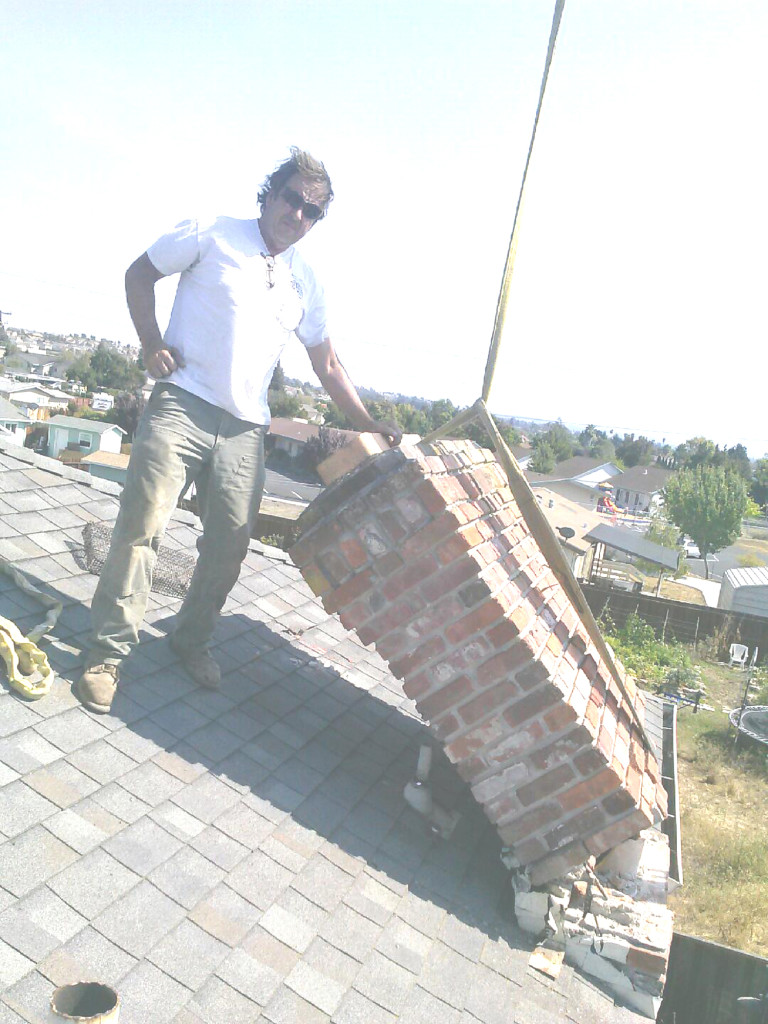
PHIL JOY’S FIRST of many repairs after the Aug. 24 earthquake — removing a broken chimney from one of his rental houses in American Canyon.
Leo Vargas photo
 ABOUT A WEEK AFTER THE NAPA EARTHQUAKE, I started receiving texts from my buddy Phil Joy, the house-lifter, that included photos of damaged houses and buildings. There were images of walls slanting and front porches with their posts all leaning at the same wrong angle. Phil was getting called by the owners of the worst-hit structures and then having to come to terms with the damage in order to plan a fix for it. He was in a unique position to understand this quake’s real impact on area buildings.
ABOUT A WEEK AFTER THE NAPA EARTHQUAKE, I started receiving texts from my buddy Phil Joy, the house-lifter, that included photos of damaged houses and buildings. There were images of walls slanting and front porches with their posts all leaning at the same wrong angle. Phil was getting called by the owners of the worst-hit structures and then having to come to terms with the damage in order to plan a fix for it. He was in a unique position to understand this quake’s real impact on area buildings.
I had already seen the damaged brick and stone buildings in downtown Napa. Phil said the damage that amazed him the most occurred in the subdivisions west of downtown, where a crack in the earth had been created by the earthquake. The crack was very narrow — maybe a quarter of an inch, the sort of thing you wouldn’t think twice about if you were to walk by it. But it ran for miles and was the focus of the worst of the energy. Where it crossed roads and sidewalks, it left behind split and tilted pieces of asphalt and concrete that looked like skateboard jumps. Where the crack ran under houses there had been extra havoc for those unlucky homeowners.
One-story homes that normally would have had just shaken badly or had furniture topple were instead torn from their foundations. As Phil described what he was seeing in these buildings, he seemed to be in awe of the strength and sheer willfulness of the earthquake to damage certain parts of these houses.
All sorts of strange things had happened in this quake. There were firsthand reports of dry creeks starting to flow again right after the shaking stopped. In one of the houses, a grand piano had been flipped upside down; its legs were unbroken. This meant that the house had endured a bucking action severe enough to rotate an object weighing many hundreds of pounds. What must that house have undergone to do that to a big piano? I knew then that what we had experienced in Benicia was a small fraction of that energy.
I passed along the most interesting stories to Melody. She suggested that I tag along with Phil to see some of these houses. There’s an intriguing idea, I thought. I’d probably learn some things about how buildings behave under stress, and in a much more dynamic way than any book could convey. Phil liked the idea and proposed we include our wives and do a Sunday morning tour to visit some of the houses he was starting to work on.
With all of us in Phil’s big four-door pickup, we drove the side roads of western Napa, heading north. At one point I felt a small bump in the road. “That was the crack,” Phil said. We drove on and turned northwest. Another mile ahead the crack crossed the road again, so we stopped to examine the small ridge of asphalt it had created. I saw that it had shifted the road about 2 inches sideways. Some patching compound had been applied to smooth over the worst parts of the ridge. It all seemed tame enough, until we walked over to a nearby house that Phil had been called in to fix. At first glance the house seemed fine, with no real damage. Then my attention was turned to the base of the walls where the stucco was badly bent out. In the back, the top of the foundation was exposed where the house had slipped many inches sideways. The bolted wood plate on top of the concrete had actually ripped apart.
Looking through a window, the inside of the house looked normal. Someone had cleaned up and it was hard to feel a sense of drama about the problem. But because the house had torn free of its foundation, it was as good as doomed (and a recipient of the dreaded “red tag” barring entrance). That is, until house-movers come to raise it 5 or 6 feet so a new, stronger foundation can be built below; then the house can be lowered and reattached to the foundation, extra strong this time. Phil explained that all these houses return to their flat and upright state very readily, almost like they want to, because that’s how their framing was set up to be.
At another house much farther north along the crack line, I saw that the corner of a concrete foundation had split open, revealing the steel rebar inside. This was amazing damage — not because of its size, but because these houses were low-rise structures built within the last few decades and were considered low risk for this sort of damage. They simply had the bad luck of being directly above the spot where all that energy miles below had manifested as a surface fracture that had shaken things madly in different directions.
One resident I spoke with described his experience. He was awakened by an enormous boom and jolt that popped him upright in his bed, followed instantly by what seemed like a freight train crashing, endlessly, into his house for what felt like an hour, but really was about 20 seconds. He thought he and his family were going to die. Through his wildly swinging window blinds he saw a bright flash of light that seemed like a flaring streetlight, followed by several more flashes, some far away, some near, as if transformers were exploding. His young daughter said from her room the lights looked like ghosts.
I later learned that this was a phenomenon called “earthquake lights.” It’s like lightning that flies out of the Earth when earthquakes happen. For real. Scientists are unsure about the cause because it’s impossible to know when and where to set up to study it. Some earthquakes produce floating sheets of light sort of like the aurora borealis. In Napa it was more like lightning. I say this with some assurance because I went online to see footage from surveillance cameras at the storage yard of the Napa Wine Train that show earthquake lights popping off in the distance. You can too. Go to YouTube and enter “napa wine train earthquake.” It’s grainy, but the earthquake lights are undeniable. Phil talked to a winery owner who saw his vineyard bursting with bright lights during the earthquake — just like transformers blowing all over grape-covered hillsides that certainly had no transformers. Earthquake lights are real.
All the people we met in these neighborhoods were of good cheer and expressed gratitude to be alive and unhurt despite their big financial setbacks. Almost no one had earthquake insurance. Those who did had deductibles so large that the insurance companies did not have to pay for the first $100,000 or $200,000 in damage. Holy moley!
Are there important things to learn from all this? Methinks there surely is. Next column: The lessons I’m taking away from the Napa quake.
Steve McKee is a Benicia architect specializing in residential design. He can be reached on the Web at www.smckee.com or at 707-746-6788.






Leave a Reply